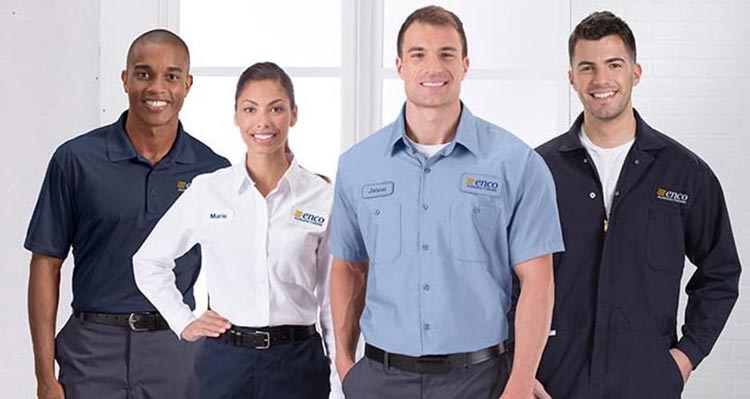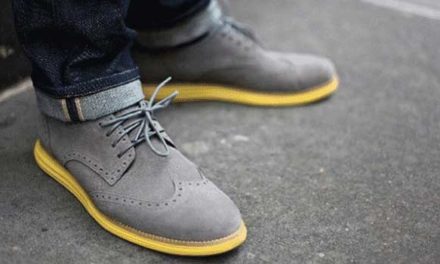Did you know you are what you wear? It’s true – how you dress has a significant impact on how you behave. That includes how well you work as part of a team.
A hockey team displays perfect coordination as they score the winning goal in a playoff game. A group of uniformed volunteers syncs together like clockwork as they help clean up an oil spill. A gathering of fraternity brothers band together at a pep rally; all wearing shirts that proudly display their house.

What Do These Examples Have In Common?
Simple – each one is a demonstration of how uniforms inspire us to work better together as part of a team. By clothing themselves in similar attire, teammates form a unique, nonverbal bond with one another, both on and off the field. Because they look similar to one another, they’re likelier to trust each other.
One reason for this is the fact that human beings possess the innate tendency to view those who look similar to themselves as more trustworthy. According to a study published in Science Daily, this works in reverse, too. When we deem someone trustworthy, our perception of them actually changes; we see their faces as more similar to our own.
In a sense, then; it could be said that uniforms ‘fool’ our subconscious. They make the people we’re working with a look similar to ourselves, in turn making us feel more strongly that we can rely on them. There’s more to it than recognition and trust, as well – as it turns out, clothing actually changes how we feel and act, and the concept of the uniform is deeply ingrained into us right from birth.
Clothing In General
“While clothing continues to serve the purpose of protecting human beings from adverse environmental circumstances, the functions of clothing are vast and varied,” writes Emily Van Sonnenberg of Positive Psychology News. “What we wear can be an implicit, non-verbal way to express our unique personalities.”
“Clothing can enhance our psychological states, and can improve our performance on a task,” she continues, citing cognitive psychologists Halo Adam and Adam Galinsky. “These researchers believe that clothing holds symbolic meaning. They claim that the influence of clothes depends on both wearing the clothing and the meaning it invokes in their psychological schemas.”
In other words, by putting on a team uniform and accepting what it means, you’re actually changing your thought process to be a better team player.
There’s a historical precedent for this, as well. As I’ve already mentioned, the notion of uniforms is ingrained in us from birth – and, some would argue, well before that. Consider, for example, an experiment carried out in 1958, which switched an active lifeguard and a stewardess without changing their uniform.
“With the flight attendant in the lifeguard hut and the lifeguard taking charge in the cabin of the plane, the first indicator that something awkward was afoot was that the uniforms of these individuals were completely wrong,” says Matthew Ortiz of Psychology Tomorrow. “Save for the fact that in the 1950s the men did the lifeguardin’ and the women did the stewardin’, what gave it all away from the start was that their costumes were completely off and were fundamentally inappropriate.”
“The function of the uniform,” he continues, “is to set aside a particular band of folks from the larger whole and to make their separation evident by dressing them all in the same garb. The uniform can give us something to live up to; a role to fill….Uniforms have seeped deep within our personal and collective psyche in one way or another. “
If you want a more current example of the impact uniforms can have on your thought process, you could also look at the (somewhat disheartening) trend of police force militarization – which the New Yorker’s Maria Konnikova has linked, among other things, to each officer’s choice of uniform.
“There are currently no federal regulations monitoring when police can swap blues out for SWAT ensembles; that determination is entirely local – and, as Peter Kraska, a professor of criminal justice at Eastern Kentucky University, has documented, it is also increasingly common,” she explains. “The decision of which gear to use in a given situation can have deep repercussions…Military gear may harm relations between police forces and citizens not because they signal violence but because they may, in some cases, cause more violence. The same cues that signal ‘army’ and ‘conflict’ to civilians may affect police officers themselves.”
“When they ‘dress up’ for serious engagements, they no longer feel like law enforcement, but part of a broader military machine,” she adds.
So, we’ve established that what you wear has a measurable impact on how you behave and that similarities between individuals make them likelier to trust one another. How can you put this into play to get your own team to better mesh with one another? For that, I’d like to point to John Tauer, a coach at the University of St. Thomas with a Ph.D. in psychology.
Everything about how Tauer teaches is meant to inspire teamwork; from his recruiting methods (he seeks selfless players) to his uniforms (they display the team name rather than individual names and numbers). He won’t even list individual points totals on the Schoenecker Arena scoreboard; this would, he says, send the wrong message to players. The results speak for themselves – his team seems nigh unbeatable.
Perhaps not everyone can be like Tauer – but at the very least, I believe his methods drive home the importance of having a great and inspiring uniform for your team. At the very least, it’ll make them a bit more efficient – and at best, they’ll work together like a well-oiled machine.















